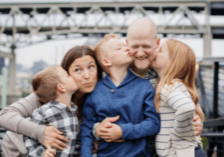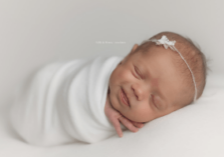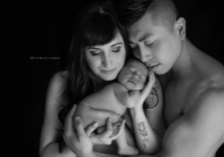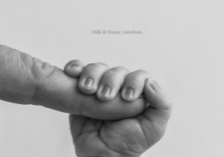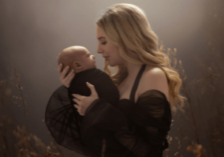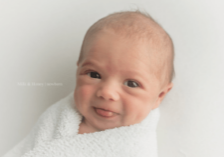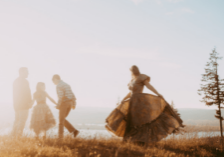Capturing Clicks: Navigating Advertising Strategies for Photographers with Ashleigh Taylor
If you’ve ever been intimidated by ad strategies for your business, you’re not alone. Click-through, conversion rate, ad copy, lead generation, boosted ads – it’s enough to make your head spin if you aren’t sure what you’re doing or what it all means.
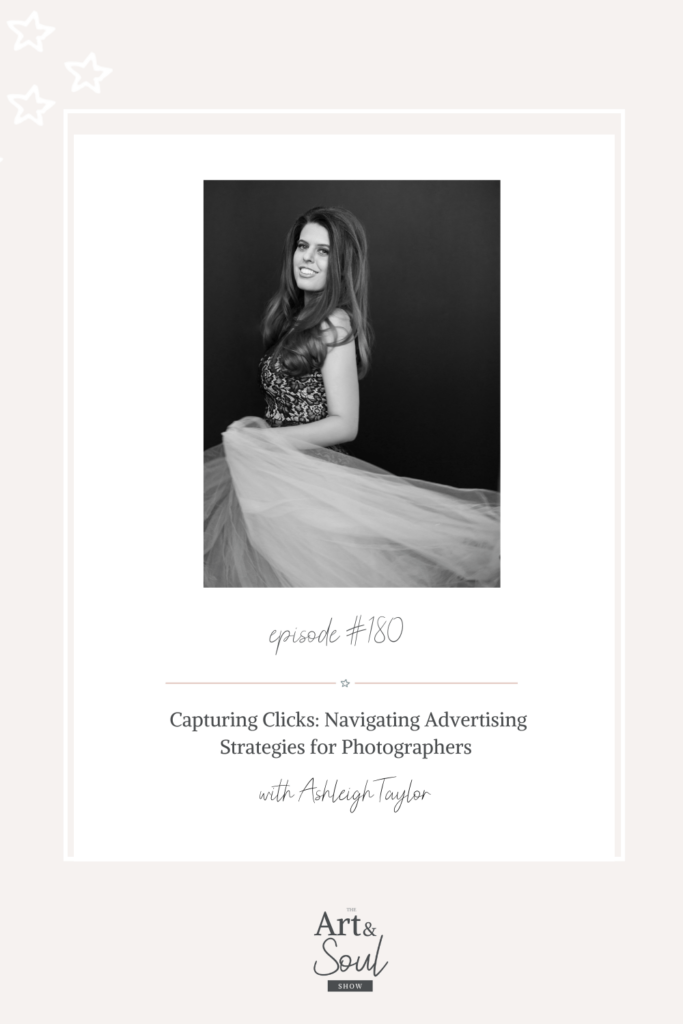
It really doesn’t have to be so scary, though. There is so much information out there to help you become a more informed business owner and figure out how to use ads to your advantage. Don’t be afraid to give it a try and see what works for you.
In today’s episode, I’m interviewing Ashleigh Taylor, an award-winning portrait photographer and photography educator and speaker. Ashleigh shares what she’s learned about using ads to grow her business, why you need to diversify your ad strategy, and how to know if your ads are working.
What’s in this episode:
- [03:18] How to build confidence as a creative and ask for what you’re worth
- [09:50] Why photographers should diversify their ad strategy to include things like Google ads and not rely solely on social media
- [17:26] How to know if you can afford ads and why most people don’t understand how ads really work
- [25:46] How to know if your ads are really working for your business or not and how to improve your conversion rates
- [30:13] Why we should be transparent about pricing and value
- [39:08] How to attract the dreamy clients that you’re excited to serve
Tune in to this episode for how to diversify your marketing and ad strategy as a photographer.
SUBSCRIBE: Apple Podcasts | Spotify | Stitcher
Want to put an end to awkward moments in your photo sessions and create genuine connection? Download The Storyteller’s Toolkit today, featuring 200+ emotive photography prompts, so you’re never left wondering what to say.
Meet Ashleigh
Ashleigh Taylor is an award-winning portrait photographer and photography educator speaker. With 13 years in the photography industry, Ashleigh has built a six-figure studio and loves coaching other photographers to do the same. Ashleigh is an official mentor with the portrait system and an educator in the Portrait Masters store. Ashleigh has spoken at the Portrait Masters Conference, WPPI, and ClickCon. Ashleigh’s photography has been published online and in print in publications such as Style Me Pretty and The Knot Magazine.
Connect with Ashleigh
Did this episode inspire you to diversify your marketing and ad strategy as a photographer? Check out this episode Marketing Mashup: Past Guests Share Their Best Advice on Marketing and Making an Unforgettable Experience for Your Clients that offers you even more insight on finding alignment in your business!
Transcript
[00:00:00] Ashleigh Taylor I’m on this ride forever, but I know there have been ups and downs and I’m sure there will be a lot more ups and downs as the years continue. But it’s not really failure. If you learn from it and you get up and you keep trying. And sometimes our darkest moments and hardest lessons give us the biggest highs later. And it’s not until we’re at that high mountain top that we can try to get back to that low valley. But that is part of the resilience of being a business owner.
[00:00:31] Lisa DiGeso Welcome to the Art and Soul Show where we dive into heart opening chats on photography, business life and that messy between. I’m your host, Lisa DiGeso, a mom, a photographer and entrepreneur, and I’ll be sharing honest conversations and advice for photographers with insight on mindset, entrepreneurship and creativity. The goal of this podcast is for you to be able to gain insights and strategies that will get you real results. Because let’s face it, having a photography business can be lonely, but it doesn’t have to be. This is the place you can go when you need a boost of encouragement, a kick in the pants and inspiration to pick up your camera. This is the Art and Soul Show. Hello, my beautiful friends. Welcome back to the show today. I am super excited to dive into my conversation with Ashleigh Taylor. Ashleigh is an award winning portrait photographer and photography educator speaker. With 13 years in the photography industry, Ashleigh has built a six figure studio and loves coaching other photographers to do the same. Ashleigh is an official mentor with the portrait system and an educator in the Portrait Masters store. Ashleigh has spoken at the Portrait Masters Conference, WPPI and ClickCon. Ashleigh’s photography has been published online and in print in publications such as Style Me Pretty and The Knot Magazine. And I first discovered her on Instagram through an ad through a Google ad, which is like super pertinent to this conversation because I’m working a lot today. So welcome, Ashleigh.
[00:02:04] Ashleigh Taylor Thank you. Thank you for having me.
[00:02:06] Lisa DiGeso So tell us who you are and what you’re passionate about.
[00:02:09] Ashleigh Taylor Yeah. So I’m Ashleigh Taylor. I am a portrait photographer. So I came up. Well, first I started in weddings, but in 2015 I got burnt out and quit that. So we won’t talk about that, I think. But I came up kind of in the Sue Bryce glamor portrait studio world, so I really actually love shooting boudoir and glam, kind of like a hybrid of the two of them, and also personal branding which I know feels like so different than like glamor in lingerie. But I feel like it’s all about confidence at the end of the day and I guess if I was going to pick like a through line to even my coaching as well I would say that it always comes back to confidence because I really like helping people find their confidence, Whether that is feeling like a star in front of the camera or that is with running your business and making money, feeling confident making money. Because I know as someone who is creative, it can be this constant struggle between your creative side and your hustler side and how to marry the two. And sometimes you can have confidence in one area and not the other. And so that’s really where I like to help people.
[00:03:18] Lisa DiGeso It’s so true because I know I have a lot of creative confidence, but when it comes to asking for what I’m worth, that is the hardest thing. How do you get to that point where you’re like, I am worth this? And it comes down probably to self value and like there is so multilayered. So how do you help your clients get to that point where they’re are able to ask for what they’re worth?
[00:03:45] Ashleigh Taylor So like you said, I do think it’s a lot about self value and mindset. And I think there’s again, like you said, it’s a multilayered path and and there is no arrival point I also want to say, because I also think that like the higher you climb then there’s like you get to this new level and then what felt like big scary numbers to ask for a few years ago that now feel easy there’s new big scary numbers that you might want to be going after. So there is like this never ending kind of arrival where there’s always like a little bit of a carrot we might be chasing after. And I do think it’s as much a spiritual journey being a business owner as it is being, you know, this actual like logistical, systematic business. But one trick that I really like to tell people is to do two things. One is connect to your why. Why are you passionate about helping this person? And then two, connecting to any form of testimonials that you have. Because I think that with creatives and with myself, imposter syndrome can be extremely high. And so we need anchors to remind us that sometimes we paint a harsher picture for ourselves than what’s true. And when you as a photographer read testimonials about how you’ve helped literally change someone’s self-image or you’ve given them like amazing memories or something beautiful to look at all the time, that really is like, Oh yeah. That’s why I’m doing this and that’s why I’m good at this and that’s why I’m worth it. So I think any time before you get on a sales call, for example, or like an initial inquiry call, it’s really good to have like a kind of anchoring practice of taking 5 minutes to breathe, shake your body and get some of the nervous energy out. Read through past testimonials and not just skim them, but like, actually take it in and soak in those words. And if you can have like a little spiritual practice around that and then also kind of set an intention for the call which isn’t attached to an outcome. So usually I like to say something along the lines of like, I’m just here to help someone decide if this is the right fit for them or not, and if it’s not the right fit for them, a better client will come along. So if not this, then something better. And it kind of just helps diffuse the situation so that it’s not now about like, Oh my God, do they think I’m worth it? But it’s just about can I help this person decide if this is aligned for them and also if it’s not aligned for them, I don’t really want to be working with them either.
[00:06:26] Lisa DiGeso Totally. That’s huge for me, is making sure that things do feel in alignment because there’s so many times and it’s funny, I recently just did a TikTok on this about firing a client with love. Like when you get to that point where they, you know, they’ve booked you, but you kind of come to realize like, oh gosh, like maybe this isn’t the client for me. Maybe this doesn’t align. And I think that’s like another like next step in our self-worth that we’re like, okay, like this isn’t going to fit, but maybe this is a great person for someone else. and so when you look at it that way as like, okay, it’s not fit for me, but this is now a positive for someone else to take on. It feels like you’re letting them go with that love versus like, I’m dumping you or you’re dumping me. Like, you know what I mean? Like, it takes have negative feeling from it.
[00:07:13] Ashleigh Taylor Yeah and sometimes it’s also like what they want as well. Like a long time ago when I was a wedding photographer, I remember having to kind of, like you said, fire a wedding client. But it wasn’t really firing the wedding client because they were clearly unhappy as well. And it was clearly not working for either one of us. My anxiety came from it was getting kind of close to their wedding and I felt like if I let her go, she won’t be able to find someone new. But I actually like got to have the full conversation and say like, This is what I’m thinking, that you would be better off with another photographer. But I also don’t want to, like, ditch you before your wedding if there’s not enough time to find another photographer. But as soon as I said that, she was like, quickly, like, Oh, yeah, I can find another photographer. So, like, she was happy and like, you know, And then I was like, Great, you know, because then I was like, everyone’s happy. So sometimes we think we owe someone something and it’s like, they’re not wanting that either. They’re wanting to move along as well. So it was like a mutual what is, what is like a conscious uncoupling. So that’s kind of what it was. And sometimes you just have to I mean, it’s rare and I think that was really like the one time in my career, but it was necessary and I’m so glad I didn’t go through with that wedding.
[00:08:37] Lisa DiGeso It’s so funny because, you know, that sparked a memory for me because I had a client a few years ago and she loved my work, but she also really loved lifestyle work and she felt really obligated to go with me for her newborn session. And then she’s showing me all these Pinterest things and like it really was lifestyle. It looked nothing like my work. And I was like, you know, what would be really amazing is this other local photographer that does this style. And I was like, just, you know, if you wanted to do a family session later on, that’s cool. But I really think what you’re after is what this person can do. And she’s like, Well, I really I really want you to do it. Because I was like, I just can’t deliver that. That’s okay, right? Fly little bird.
[00:09:15] Ashleigh Taylor Exactly. And then everyone, like you said, wins because the other photographer wins. The client wins because they ultimately get what they want. And then you win because you’re not going down this road of trying to create something that you can’t create and then making someone unhappy with the expectations. And yeah, so that is definitely expectations are everything.
[00:09:37] Lisa DiGeso Right? It’s just like getting into that alignment of like your self and like what you can provide and what you want to do. Like as soon as you’re in that zone, like that’s where the magic happens. All right. So we’re going to switch gears. We’re going to dive right into like some marketing. Okay. So so many of us photographers that especially those that have been at it for a while, we’ve just relied on posting on social media as our ad strategy. Now, can you share maybe why diversifying and learning other methods like Google ads is really important for photographers?
[00:10:09] Ashleigh Taylor Yeah. Well, I also want to clarify something. So posting is not an ad, it’s just organic. So advertising means you have advertising dollars and budget behind it. It’s totally different. So there is a lot of confusion over those two things in the industry. And then also boosting a post is technically an ad because you are paying for it, but that’s actually not the proper way to run ads. So that’s another just point of confusion. Sometimes people will say, I run Facebook ads, but they’ve boosted a few posts and that’s really not exactly the same thing, although it can feel like that boosting is essentially like not to sound mean, but it’s like, you know, those books for Dummies, it’s kind of like Facebook Advertising for Dummies is what boosting it is. It’s just to make it really accessible. Another point of clarification would just be the difference between Google ads and Facebook ads which two different tech companies. Right. So Facebook is really Meta now and Meta owns Facebook and Instagram. So those would be ads that are placed on those platforms and Google ads owned by Google. It’s, again, a huge network of ads. So anything that Google owns, you could have YouTube ads or display banner ads or ecommerce ads. But for photographers, what I have found in my experience is that the search campaigns and smart campaigns, which essentially like show up when a person types in a search to Google, and if you’ve designated that exact search or something extremely similar, your ad will then pop up at the top of the Google search results that that person typed in. So just to make it super clear, if a person sat down at their computer and typed boudoir photographers in Santa Barbara and I have designated that as one of my targeting keywords, then my ad will pop up at the top of a Google search result. Does that make sense if it’s matching? So two totally different types of ads.
[00:12:08] Lisa DiGeso Now, would you say one is more effective than the other?
[00:12:10] Ashleigh Taylor So yeah, that’s a great question. And I’m not even sure if I answered your original question, which is like why it’s important to do. So let me just back on that. So why is it important to do? First of all, not everyone is cut out to run ads. They do want to say that because you have to be in a point of your business that you are willing to invest both the money into the advertising and time to really understand what you’re doing. Because a lot of photographers, I think, think that it’s going to be some like little magical situation where they just set up an ad and they don’t really understand the ins and outs of it, and then they swear them off because they say they don’t work. But the thing is, when you do invest that time and money and you do understand how that works, or of course you get an agency or someone to do it for you, you can really see amazing results because what’s happening is you’re essentially buying back your time. You are showing up either on Google or in people’s Facebook and Instagram feeds. And we all know organic reach is very low these days, right? So you’re showing up at a much higher rate and you’re just getting in front of more people. And so therefore you are getting more visibility and then hopefully getting more leads and clients. Right. So that’s why to do them. Google ads or Facebook ads, which one is better? I teach both. I run both and I love both. They are symbiotic. I don’t think one is better than the other, but they do work really differently. And so it’s important to understand what that is. So a Facebook or Instagram ad shows up in your feed as you are scrolling. We’ve all seen them a million times, right? They can be targeted different ways. They can be targeted toward a warm audience. So someone who’s already been to your website or been to your Instagram, so an ad like that might look like reminding someone to book a photo shoot. Hey, you’ve already been interested. Or perhaps the ad copy is answering an objection, like something around maybe money objections, which is a common one. Or maybe if it’s a boudoir shoot, I know losing weight body issues tends to be in the boudoir space. Right? So why why do the session if you aren’t feeling confident in your body right now and then it can answer that objection. That would be like an example of a really good idea for retargeting ad. You can also target cold audiences so people who aren’t familiar with you and then you’re kind of working with demographics and interest. There’s no exact, in Facebook, there’s no exact way to say, hey, this person really wants to do a photo shoot, right? There’s no targeting around that. So typically with a Facebook or Instagram ad, you do have to come up with some sort of campaign or offer that is so enticing that it stops people in its tracks and it makes them, even though they didn’t wake up that day, necessarily have it on their radar to book a photo shoot, they’re now highly interested in booking a photo shoot. Google on the flip side, you’re targeting it based on the keywords that have been input, right? And people are searching. So what that means is if someone woke up that day and they actually went to their computer because they are searching for a boudoir photographer, they’re already educated, that they want a boudoir shoot, they just don’t know who to hire and they don’t have maybe anyone to ask for a personal referral. So they’re sitting down and they’re typing in something like boudoir photographer near me, boudoir photographer Santa Barbara, professional boudoir studio, something like that. Right. You can again target for those exact search terms and then you will show up when the searches align. So that is the power of Google ads is that the person was actively looking specifically for a photographer. And so what I found is that lead costs can be higher on Google ads. However, they also convert at a much higher rate because they were already very interested in booking this shoot.
[00:16:12] Lisa DiGeso Because they’re already searching for those terms. Yeah. And you’re like, okay, well, here’s your like, top of the menu.
[00:16:17] Ashleigh Taylor Exactly. Exactly. And so it’s just most of all ask to like, well, why run ads if I’m already showing up at the top of Google and so like you have good SEO. That’s a great question and obviously for the person who has really good SEO, maybe it’s not as important, but there are so many competitive markets out there where, I mean, we all know it can be really fickle and hard to get at the top on the first page of Google and stay there. And also there’s a know, like and trust factor here. So the more times someone sees your name on the first page of Google, even if it’s in an ad, that’s not how our brains work. We just see something a bunch of times than we already believe that it’s the best, right? So if you even are someone who comes up on the first page of Google, like maybe in the map section, maybe in a listing, and then now you’re in the ad, you’re in three spots like that makes you look pretty like subconsciously in the 2 seconds that people make little decisions without even, you know, first impressions without realizing it. You’ve already made a strong first impression because your name showed up three times. So that is another reason why ads can be so powerful.
[00:17:26] Lisa DiGeso Now because I know that you can burn money really quick on Facebook ads and probably Google ads, too. How do you know whether something is successful and how do you know to stay within a budget? And what would you even really be spending and afford?
[00:17:41] Ashleigh Taylor Yeah, so obviously is it’s a complicated question. I do kind of cover it in detail in my in my courses, but I will try to like topline it right now without getting too complicated. So obviously, you do have to understand what you can’t afford to spend. And numbers are going to depend also like on how much you charge and what your average sale is, right. Because you can afford more if you are hiring higher rate, but also your lead cost might be more if you’re a higher ticket because you it’s you’re asking for a client who is not the everyday client. Right. So not everyone is willing to just drop $2,000 on a photo shoot. So you have to keep those things in mind. As far as like burning money, this is a question that gets asked a lot, so you can definitely overspend. But if you are managing your ads, which means you don’t just set them up and walk away from them, or you don’t just keep throwing money at it for no reason. But if you actually are educated on like what is a conversion rate, what is a click through rate, how are my ads stacking up? Like what changes do I need to go ahead and make because I’m not seeing the results that I’m after? If you’re educated on those things, it’s more of a science experiment than it is a burning money. Because even if you aren’t getting the results you want, you are getting data. And if you’re analyzing the data correctly and making the correct next step moves from those decisions that you like. From the data that’s come in, you are just getting information that you can use to improve down the line. It’s just a common thing that people will spend $100 freak out and then swear them off forever. That’s not really the way you should think about it. You should think about it like I spent $100. I was hoping to have a lead by now. Let’s go look at this. Do I need to change my ad copy? Maybe. Let’s go look at my conversion rate. Is this web page actually doing a good job communicating what I do? Do I need to tweak my calls to action? Like really looking at the steps here and analyzing it and seeing how you could be better. Because the truth is that there are photographers out there having success with ads and there’s businesses of all kinds having so much success with ads. So it’s not like the world isn’t conspiring against you. And ads don’t just personally not work for you. You just have to refine your process.
[00:20:12] Lisa DiGeso Totally. It’s like trying to use the camera and like setting everything up. But you put your lens cap on and you’re like, Oh, my camera doesn’t work.
[00:20:18] Ashleigh Taylor Yeah, exactly. Or your batteries died or something. And we all start somewhere and it’s like, no one like, is born an advertising genius, like, especially as photographers. So if you want to learn this, you have to understand that it’s you want to learn this because you see the value in buying your time back and you’re you don’t have more capacity to do more networking and you want more leads and bookings, but you just don’t have the capacity to do any more of the free or free is a misnomer because it costs time or in some cases it does cost money, like networking events, I think people forget that they cost money. What I’ve noticed is it cost me like $125 typically to go to a luncheon in my town. And sometimes I don’t see any immediate return on investment. Of course, I’m making great relationships and I’m not knocking networking at all. It’s been a huge part of my business and I still do it. But I just think there’s this funny thing people say networking is free and it’s like, Oh. I don’t know what’s going on in your town, but in my town it is not free.
[00:21:26] Lisa DiGeso Literally. Well, even like if you think about the time, like whatever you’re going to be making, like what do you earn per hour plus like if you have to drive there the cost of the lunch and like parking even and like it adds up and you’re like, well, what if you took that money and also put that into a Google or Facebook ad?
[00:21:42] Ashleigh Taylor Yeah, exactly. So that’s what it is, it’s just buying your time back. And then there is that like some people say, okay, well then I’ll just get an agency to do it, which that’s great. I’m not saying not to do that. You just have to be aware that agencies are expensive. You pay an agency fee and then of course, you still have to pay your ad budget fee at your ad budget, you have to pay Google ads for whatever they’re spending. So that’s usually the cost times two, right? So like you might be paying an agency $400 to $800 a month, maybe more, to manage your ads, and then you’re paying #300 to, I don’t know, $1500. Some agencies also have high minimums, like they want you to spend $800 a month on ads to even work with them. So now you’re talking over $1,000 to work with an agency every single month when you could be doing it yourself for significantly less. And then not everyone has the time or desire to do that, so that extra money is worth it to them, and that’s totally fine. But that is just a common question I get asked is like, why not use an agency and and some agencies don’t even specialize in working with photographers either. So that’s another, I actually decided to learn Google ads because I had a negative experience with an agency and they just couldn’t get my ads dialed in and I was like, $5,000 later, I’m kind of over this. So I decided to, I was like, You know what? I learned how to use Facebook ads so I can learn how to use Google ads.
[00:23:14] Lisa DiGeso I love that. I know. And there’s like, there’s so many there’s Pinterest ads, there’s like TikTok ads. Like, there’s so many different ways to diversify.
[00:23:22] Ashleigh Taylor Yeah. And I don’t even know anything about those.
[00:23:30] Lisa DiGeso I love it. And also, you know, what’s fascinating, too, is like the ad cost can certainly change depending on the time of year. You’re advertising like Black Friday times are even like around Christmas, like the ads costs skyrocket. Right.
[00:23:43] Ashleigh Taylor Yeah. So ad costs vary based on time of year. They also vary based on market, like just your your industry plus your geographic location. So that’s one thing that makes it hard sometimes to teach ads because people want like this cookie cutter response to everything. And the truth is there isn’t. But I can always teach people best practices and how to think about the results that they’re getting and how to think about their budget better and how to think about how to use the ads more effectively. So it’s not I’m someone who always says, like, I can’t give you a magic formula that one size fits all because it’s going to be different for everyone. But I can teach you and empower you to understand how this whole system works so that you can make the best decisions for yourself and your business. And that’s really been my philosophy as a coach the whole time is like, how can I empower you to just understand this and think about this better so that you can make the best decisions for you? Because the best decisions for you might not be what’s best for me and what might not be what’s best for somebody else. And I think there are some coaches out there who try to give cookie cutter or like this magic formula where you just use this exact wording and this exact system, it’s always going to work and then it doesn’t. And it’s like things like that just don’t work for for everyone or in perpetuity. So that’s just not the coach that I want to be for people.
[00:25:08] Lisa DiGeso I love that because it’s like we’ve been in business for like, well, 13, 14 years and we’ve hired coaches. And it’s funny because things and it’s typically never within our own industry. And so when it is that like cookie cutter approach that everything should be working for everyone and you’re the one that it doesn’t work for. How do you think like that makes your mentor? You’re like, whoever you’re helping feel like it makes you feel like you’re just like unhelpful and like your industry sucks or like your business is a failure. Yeah, right. And instead, like, and instead I love that you teach it. You empower them to work with what works for them. I love that.
[00:25:44] Ashleigh Taylor Yeah, exactly.
[00:25:46] Lisa DiGeso So good. So how do you know if your ads are working or not?
[00:25:49] Ashleigh Taylor Yeah. So, I mean, the basic would be, are you getting leads or are you getting what is called conversions in the ad space? So you do have to set your ads up correctly, which I teach to track conversions. And from that, not only are you getting leads, but you can also see your conversion rate within the analytics of your ad. And so there are different metrics. But in Google ads, for example, if your ad is not converting it at least 1%, you’re really in trouble and you want it to be between three and five. That would be great. And if it can be even higher than that, obviously even better. But that is just like a kind of key metric, because if your ads are not converting, if it’s not getting new leads, then that’s a problem. Because that’s the whole point of the ad. And a lot of people either when they’re learning through YouTube or other online courses I’ve noticed, don’t learn conversion tracking. They learn to just send traffic to the page, which is not the best way, because just because you’re getting a lot of traffic doesn’t mean that you’re getting a lot of inquiries. And so when you don’t have the conversion rate metric, you don’t really have the full picture. So it is really important to set your ads up for conversions. And if that’s like crazy lingo, that doesn’t make sense, I’m sorry. I know sometimes it’s like when I started in photography, even hearing the word leads to describe an inquiry. Why do they keep saying leads? I don’t like that. I just say inquiry.
[00:27:28] Lisa DiGeso I know right. Or leads or lead magnet or lead page? And you’re just like, My brain hurts, right?
[00:27:32] Ashleigh Taylor Yeah. Yeah. Sometimes it’s just the wording, but like for the lack of just ease, a conversion is in our cases photographers an inquiry and a lead is obviously an inquiry. So think of that to be synonymous.
[00:27:46] Lisa DiGeso I love that. okay, so I have another question and it is what if you’re getting good click through but you aren’t looking? And what advice do you have for those that are maybe stuck in the click and goes, Yeah.
[00:27:59] Ashleigh Taylor So click through is just someone sees your ad and then they’re excited enough to actually click on it, right? So you’re saying people are clicking on the ad but you’re not getting the inquiries, which would be the situation where your conversion rate is low. So that usually means that there’s something wrong with the website itself that you’re sending the traffic to. Because the ad is exciting people, but they’re falling off and they’re not taking action on the website. And that can be for obviously a variety of reasons. But I would say one of the most common reasons is the calls to action are not clear enough, but it can be anything from not well written copy to the pictures not enticing someone to just the layout not being good, having too much copy where people are like, ugh. So that’s why having a really like a good understanding of what makes a page convert well is really important. And also again, having that ability to test and try things out because ads are all about testing. So maybe you need to change the page that you’re sending people to either literally send them to a different page or change what’s on the page that you’re sending people to. So that would be why I would say that’s happening. And then if you’re getting the leads but you’re not getting the actual people converting to bookings, that’s kind of again, an educational problem, right? So they got a certain impression from the ad in the website that when they get the full picture from you, it’s not aligning. And that’s again where it gets really hard for me as a coach to like kind of people say like, what can I expect my results to be? And it’s like some of this is on you. You have to be good at converting your leads into clients. You have to be aligned in your communication the whole way through the process. So again, I love to help people think about this and guide them as much as I can through the process. And I love for students to take ownership that some of this is on you and you need to really self audit on where are the holes in my communication, where can I find my systems better and where maybe am I not in alignment with my own communication?
[00:30:13] Lisa DiGeso What’s your view on having your pricing right on your website?
[00:30:16] Ashleigh Taylor I think it’s a good thing because obviously if we’re out of someone’s price range, like why, you know, then you’re paying all this money for leads and ads and if the bulk of those people can’t afford you. Yeah, that’s unless you want to have an associate photographer who is at a lower rate which potentially could do but that’s like, you know, at the end of the day, I think people I like to think of myself too as a client and like I value my time, so I don’t mind getting on the phone with someone if it’s a service I’m really interested in. And it’s a high touch, high ticket to learn more about it. But I at least want to know if I can even afford it. So I don’t think you need to have and I wouldn’t even recommend having like every package and every single detail because that can get overwhelming. But you should at least give people an understanding of what they can expect to pay. And I even have now on my contact form a button that says, I understand that prices start at $1197 and go up from there depending on the package, and that is in my budget. Basically because I don’t want to work with someone who doesn’t understand that and it kind of gives me anxiety at this point to get on me, anxiety to get on the phone with people if they aren’t aware of my prices because I don’t like getting told that I’m not worth it.
[00:31:37] Lisa DiGeso I know it’s like this is like soul crushing, right?
[00:31:41] Ashleigh Taylor So I’d rather just no one do the inquiry. And I mean, the truth is most people don’t actually finish filling out the inquiry if they see that it’s not usually once an inquiry comes through, it’s like, yeah. And then I’m like, Great, I’m happy to get on the phone with this person now. So it changes my energy and how I show up as well.
[00:31:58] Lisa DiGeso Totally. It kind of reminds me like if you were to see like a beautiful million dollar mansion and you’re like, I don’t know if this is like 200,000 or this is like 5 million. And I’m still going to like, email the realtor and, like, just book it. Like, that’s why the the prices are listed because we know we can afford it, right?
[00:32:18] Ashleigh Taylor Yeah, exactly, and I think there’s this, like, this thing in our industry that’s like, oh, like affordability isn’t real. If people really want to work with you, you can overcome anything. And I think that is to some extent a little bit true and it’s also a lot not true. Like it’s a more gray area than that. There are people who literally can’t afford it, and that’s okay. And they’re not our client. And then there are people who can afford it and might really be interested, they just don’t understand what’s involved. And those are the people that we’re speaking to. But they have to have at least a little idea that, oh, I’m open to spending that money if it is in fact something that I really want to do and it sounds really good and is really worth it. And so I think it’s in that gray area that we need to be talking about a little bit more because not everyone has, like and it’s not even about the job that you have. It’s just like not everyone has those values. Not everyone has the extra money. And you can’t just convince anyone into buying a photo shoot.
[00:33:24] Lisa DiGeso And to be completely honest, if someone is struggling to pay their bills, if they’re struggling to pay their mortgage or get groceries on their table, I really don’t want to sell them into my package. I really don’t. I want them to feed their family until they survive. That’s more important to me than them booking me. Like, the right people will come into my life and I trust the universe is going to provide that for me.
[00:33:50] Ashleigh Taylor Exactly.
[00:33:51] Lisa DiGeso I love that you touched on that, because I think that that is something that is really wrong in our industry. It’s like if they want it, they’ll they’ll save up for it. They’ll buy it. And that’s not true because that’s coming from such a place of privilege.
[00:34:02] Ashleigh Taylor Yeah, exactly. Exactly. And there are photographers who are lower cost and for some people that that is all they can do. You know, I know people who when the school offers a little fundraiser photoshoot for 150 that is the only photo shoot they can afford and like thank God that they get to have their family photos taken, you know?
[00:34:26] Lisa DiGeso Yes. Thank goodness there is options for every single budget. That’s beautiful. That is. We need that in our industry.
[00:34:36] Ashleigh Taylor Yeah, exactly. And then it’s our job to communicate like, okay, so that exists. And why is that? Like, how are we different and why are you paying these prices? And I think and not in a defensive way, but just in a like, let me paint the picture for you of how this is different than any other photo shoot you’ve had and why it costs this amount of money. And if you want this and that sounds good to you, then let’s keep talking, because that’s kind of the way I think about it is just like, if you like this idea and you want to keep going to and sometimes people will ask me straight up like, well, gosh, why is this too expensive? And I sometimes just say, you know, you heard me explain the whole experience. I have to pay my hair and makeup team. I pay rent on this private studio that we’re doing this shoot at. We’re in Santa Barbara of all places. Like we talked about the retouching that costs money as well. I just kind of walk them through and then they’re like, I’m like, this is a magazine quality product and you’re getting a celebrity quality product and it kind of has some celebrity quality pricing attached to it. And that’s just what it is. If you wanted something totally different, it would be priced totally differently. But that’s not what I’m offering. And then like some people are like, okay, then that that’s not for me. And then some people are like, Oh yeah, you’re right. I do want the glam squad and the A-Team, so I guess I’m going to pay the A-Team prices.
[00:35:58] Lisa DiGeso Some people like to shop at Walmart for the groceries. Some people can afford to shop at Walmart for their groceries, and that’s where they choose to shop. So people go to Erewhon. It’s okay.
[00:36:06] Ashleigh Taylor And some people shop at all of the above. Like I shop at Target and I’ve bought like a YSL bag before, you know what I mean? Like, because sometimes it’s like there’s a special occasion and you want to really go out for this particular thing. But that doesn’t mean that like the bag I want to carry every single day that I’m going to like, you know, when I go traveling and it’s going to be on the subway with me and like in places where it can get damaged, I just I want to take my YSL bag. I want to take my target bag, $20 after that. So, I mean, yeah, and like so some people will want the big expensive photoshoot. For a really momentous occasion in their life, and then they might do the mini sessions for their kind of annual family photos. And that’s okay too. You know, they can still be the same client and actually the same person. They just have different values for different needs in their business or not in their business, but in their life.
[00:37:04] Lisa DiGeso I love that you touched on that, too, because I think that is so funny because photographers can get so territorial about their clients, and especially when their clients go and have an experience with another photographer. And it like is is quite tricky. It’s like, what did I do? What did I do wrong? And it’s like, maybe it’s nothing. Maybe they just want a different experience. Maybe it was a different budget. Maybe it’s just they wanted to try McDonalds or they wanted to try a different restaurant and that’s okay.
[00:37:32] Ashleigh Taylor Yeah, exactly. One of my friends in this industry, Damali Shepherd, she made a Facebook post a few months ago, but it really stuck with me and it was kind of about like, it’s okay if you’re my client and you go to someone else and you want to try a different experience. Like everyone has their own signature style and signature experience and you are not obligated to me because you hired me once and I just thought it was so beautifully written and a sentiment you don’t see expressed very often. And it really stuck with me. And then it also, you know, she was honest in the post. She was like, Do I get a little bit bummed out if you go with someone else? Yes. But that’s my responsibility to handle, like my feelings of jealousy. You are your own person and you’re allowed and you should go have the experiences that you want to have in life. And I just thought like, gosh, if humans can get to this lightning point where we didn’t feel so territorial over people are jealous. It was just so beautifully written and just so like, I think the person I aspire to be is not like you. Like she said, it’s natural, I think it’s human to feel jealous or disappointed when a client goes somewhere else. But the truth is that we are offering maybe a service that for me as a boudoir kind of glam session, I do get repeat clients, but for some people this might be their once in a lifetime, go all out, feel like a celebrity experience. And that’s okay too.
[00:39:06] Lisa DiGeso Exactly. I love that. So we hear a lot about our students maybe working with clients that might not be their dreamy or their ideal clients. So what advice do you have to attract those clients that you really are excited to serve?
[00:39:21] Ashleigh Taylor So I think it’s all about that alignment in communication. So first of all, getting clear for you and we tend to do this ideal client thing, I think once in our business or maybe once every five years or something. But we can change and that’s okay. So doing this more often, getting clear on who are my favorite clients that I worked with in the past six months? Why? What lit me up? What am I excited about? What am I not excited about? And then, even though it’s a lot of work, change your marketing, which is essentially your communication, accordingly. And that’s your website, but it’s your social media posts. It’s the words you’re using in your advertising if you’re running ads, but it’s also the way you speak to people and the way you speak about your business. Change it. Change it to be in alignment with what you want because people will change when you change too, right? The world kind of is a reflection of us. And so if we’re if we’re still stuck in trying to talk to everyone who clients that aren’t lighting us up, that’s why we’re keeping attracting that right. And also showing it in the pictures like let’s say your esthetic changes. So start showing the new work. Stop showing the old work if you don’t want to shoot that or you don’t want to shoot families anymore. Stop posting family shoots, start posting the shoots you want to photograph. And if you need the money and someone calls you, it’s like, do you still do families? And you need the money, like you can take that person. But then don’t post about it on social media. I think that’s where a lot of people get tripped up too, is like feeling like they need to show everything that they’re doing all the time instead of what they really are joyful about and want to be doing. And you can curate all your communication and so you can still take those jobs if you need to take them to make ends meet. You don’t have to make that your branding. And so that way when people come, new people come to you, they’re meeting the new you because hopefully people are meeting us all the time. Right? And they’re meeting Today Ashleigh, they’re not meeting Yesterday Ashleigh, so I don’t need to fill them in on what I used to do.
[00:41:39] Lisa DiGeso Exactly. And you’re allowed to change. Like and I was saying this just not even just for our listeners for me too like, I really feel like I stick myself in a box and I just stay there and I don’t let myself deviate from like different editing styles that I like or different things I want to shoot because like, you’re almost afraid. Like, what are people going to think? And the fact is no one notices. No one’s really paying that much attention. And if you do something out there that’s wild and like fun and that they haven’t seen before, people are like, Look at you, right?
[00:42:10] Ashleigh Taylor Yeah, that is so true. And like even a coach recently said to me, like, you’re a creative person, you don’t have to you’re not expected to do the same things forever. Because I was even like expressing like, I don’t know, I’m just not as lit up by like this old style that I was doing. And I’m kind of going in a new direction. But even for me, like, it’s scary. Will people want this? Will people buy this? But she was like, You’re a creative person. You’re not meant to stay in the same box forever. That’s not what creatives are meant to do. And I do think we kind of like as a society are kind of stuck in like, you know, that like older generation where you pick one thing and that’s what you do for your whole life and then you cash out your retirement and then you’re done. And that’s really not the world we live in anymore. And it’s okay and it’s okay to change. And like, I think we’re the ones that are the hardest on ourselves about it.
[00:43:08] Lisa DiGeso I think so, too. You’re absolutely right. Love it. So, are you ready for our lightning round?
[00:43:13] Ashleigh Taylor Yes.
[00:43:14] Lisa DiGeso Coffee or tea?
[00:43:15] Ashleigh Taylor Definitely coffee. And black.
[00:43:18] Lisa DiGeso And black, or…
[00:43:19] Ashleigh Taylor Like, lots of oat milk and sugar.
[00:43:24] Lisa DiGeso Same. Most luxurious vacation you’ve ever been on?
[00:43:28] Ashleigh Taylor I feel like it’s about to have it. I’m about to go to Europe for a whole month, which is like the longest I’ve ever been on a trip for I guess I’m so I’m very excited. And part of the trip we’re going to see my friend and I are going to Santorini. And we are staying in like Airbnb that has a private pool and like an ocean views that we’re feeling very baller about it. Yeah.
[00:43:55] Lisa DiGeso I love it. Are you taking your camera?
[00:43:58] Ashleigh Taylor Yes, because it’s partially a work trip, so it’s like the. Santorini part isn’t. That’s the fun part. But it’s partially a work trip. So I’m helping Mentor teach at a workshop in Italy. And then I am also photographing a client in Paris. Which is going to be so fun. And so those are the two little work, that’s like eight days of working. And then the rest of the month is play in different cities across Europe. So I’m feeling like very excited.
[00:44:31] Lisa DiGeso When do you leave?
[00:44:32] Ashleigh Taylor Literally like in 12 days. So I don’t know, by the time this episodes out, I might be back.
[00:44:40] Lisa DiGeso I love it. I love it. Morning person or Night Owl?
[00:44:43] Ashleigh Taylor Definitely a night owl.
[00:44:47] Lisa DiGeso What did you want to be when you grew up?
[00:44:49] Ashleigh Taylor An actress. I really loved Peter.
[00:44:52] Lisa DiGeso I love it. Same. What was your favorite TV show as a kid?
[00:44:58] Ashleigh Taylor Oof! I don’t know that one because I loved TV. I still to this day, I love TV so much. I guess it’s like a little, little kid. I loved Alvin and the Chipmunks. That cartoon in the nineties and late eighties with Britney the Chippette. I loved Britney. I wanted to be Britney. She was everything. And my son is named Theo or Theodore. And he’s like, definitely named after the chipmunk which is so funny and embarrassing, but I always thought he was like, the cutest. So people will be like, is he named after the president? I’m like, No, he’s named after the show.
[00:45:39] Lisa DiGeso That’s funny and fun fact. So my son’s name is Van, and when I got I must have been like 20. That was when like Van Wilder came out and Ryan Reynolds, I was like, He is such a delight. And I was like, I’m writing that name down. Van is going to be my boy’s name. And I know for having a senator named in that. And I’m like, Yeah.
[00:46:06] Ashleigh Taylor That’s hilarious, right? And what it is what it is.
[00:46:13] Lisa DiGeso Do you have any personal projects going on right now? And if you do, what is it?
[00:46:16] Ashleigh Taylor Personal projects? I feel like all the projects they have are kind of business projects. But I am working on a new podcast, but it’s in the very early stages with a friend of mine named Kevin Condé, and then I’m working on a few new, but they’re kind of top secret business projects as well. So yeah, I have a lot of stuff cooking, not a lot I can say about any of it. And as far as like personally, no, I feel like this year for me on my personal life has just been like travel. This has been the year of travel, so.
[00:46:54] Lisa DiGeso I love it. Favorite guilty or not so guilty pleasure?
[00:46:59] Ashleigh Taylor Guilty pleasures? I mean, I love dancing. I don’t know if that’s a guilty pleasure. I like musical theater. I mean, I guess I wouldn’t really call that a musical theater, but it’s like my pleasure. Like singing show tunes and dancing around the house. Like, I am thinking I’m Britney Spears or a showgirl is definitely my pasttime.
[00:47:18] Lisa DiGeso I think I love it. Okay, so favorite musical?
[00:47:21] Ashleigh Taylor That’s too hard of a question. It’s kind of like this to me. I have like I have the top five. I have I have like different slots of musicals. Okay, So listen, I would say Cabaret is like one of my all time favorite musicals for both the music and just the message of it. Hedwig and the Angry Inch is another top favorite. Like kind of changed my adolescence musical as well as Rocky Horror Picture Show. There’s kind of a through Line theme through these musicals. Cats was one of the first musicals. I think it was the second musical I ever saw, but it’s like what made me fall in love with musicals and like, my cats had like, I have a Cats sweatshirt from the production and I was Kitty was on the hoodie now as the logo on the back and I like I don’t know if I can like say this because I’m a millennial but I stan cats like I have to be like, I’m always going to be like, if someone’s talking crap about the musical Cats, I’m going to be like defending Cats. You don’t understand a bunch of people on stage dressed as cats, singing and jumping around like, I don’t know, I can help you. That’s amazing.
[00:48:35] Lisa DiGeso Oh, so good. did you do musical theater in high school?
[00:48:40] Ashleigh Taylor I did it. All my life. By high school, I wasn’t quite, I was more into, like, nonmusical plays. I wasn’t doing it as much, but I’ve always loved it. I actually went to a performing arts high school. And the musical theater program was very cut throat, and I didn’t realize it, but by the time I guess, like out to high school, I wasn’t as skilled as I needed to be in the dance area. So you’re like competing against girls who can literally put their leg up to their head and you’re just like, Hit me. This is a memory. And like learning that level of flexibility up to this point in my life.
[00:49:23] Lisa DiGeso So funny. I love it. What has been the best piece of business advice you’ve ever been given?
[00:49:26] Ashleigh Taylor I think definitely that there is no failure. There is just lessons learned and we can look at those lessons, take what we need from them and get back up and keep going. Because the truth is there are so many hard burnt out give up moments in being a busines owner, but at the same time I would never want to go work for someone else or go back to, I didn’t really ever have a 9 to 5 but go back to like a 9 to 5 type of job. I just can’t see myself doing it. So I think I’m on this ride forever. But I know there have been ups and downs and I’m sure there will be a lot. More ups and downs as the years continue. But it’s not really failure if you learn from it and you get up and you keep trying. And sometimes our darkest moments and hardest lessons give us the biggest highs later. And it’s not until we’re at that high mountain top that we can try to get back to that low valley. But that is part of the resilience of being a business owner now.
[00:50:33] Lisa DiGeso Well said. So where can our listeners learn more from you and tell us about the course and your course.
[00:50:39] Ashleigh Taylor Okay. Yeah. Well. So my website is AshleighTaylorportrait.com and if you go to AshleighTaylorportrait.com/photographers there’s a whole page that links to free resources for photographers on education. I have two courses that are sold through the Portrait Masters store that are available for purchase at all times. One teaches organic Instagram marketing, one teaches paid Facebook and Instagram advertising. And then I do, as you mentioned, have a new course that teaches Google ads. However, it does have an enrollment window. So as we’re recording this tonight, the enrollment window closes. So by the time people hear this episode, I’ll probably have it closed, but it will be getting ready to be launched again. So the best thing you could do would be to like DM me on Instagram. And I could add you to a waitlist or you could sign up for one of my free resources and then you’d be a part of my email list and you’d be notified when it goes on sale again. But that new course teaches Google ads, which, like I said, is a totally separate thing, totally separate platform to Facebook and Instagram. So yeah, that’s kind of what I have going on. And so my Instagram is also the social media channel that I’m most active on. So if anyone wanted to learn more about me or reach out via Instagram, AshleighTaylorportrait as well is the place to check me out. And Ashleigh is spelled super funky. But I guess if you’re Looking at this podcast you can see that.
[00:52:13] Lisa DiGeso I love it. So I love to end my interviews. Just this last question and it is what are you currently curious about or artistically curious about?
[00:52:21] Ashleigh Taylor I think what I’m curious about is what else is possible for me in terms of like gifts and where I can go next. I guess I’ve been really kind of like on a weird I’m not religious at all, but like on a weird spiritual journey. And I’ve had some really interesting experiences this year and I’m really curious about like, how can I harness my intuition better and maybe tap into gifts that I think all humans are innately given, but we learn to tune out of them over time. But I’m very much at the beginning of that journey. But it’s funny because not to make this too long of an answer, but I used to always say, like people would come to my photoshoots and kind of say like, Oh, this was like a healing experience. And I’d always be like, I’m not a healer, I’m not a coach, You know, like in that sense, like I’m not a life coach, I’m not a healer. I’m just taking your photos. This is just a photo shoot. Yes, You feel beautiful, but it’s just a photo shoot. And I kind of realized, like, how much I was down talking myself and the experiences that I’ve had with people who are on the more spiritual side of coaching or healing have been so magical that it would be like, so cool to somehow infuse some of that into my life as well. But I have no idea how to exactly do that.
[00:53:38] Lisa DiGeso But I got glimpses. I love it and I’m so excited. I love it. Ashleigh, thank you so much for your time today. It’s been such a treat chatting with you.
[00:53:48] Ashleigh Taylor Yeah. Thank you, Lisa. This has been amazing.
[00:53:51] Lisa DiGeso Oh my beautiful friends. I hope you loved this conversation just as much as I did. I am sending you so much of my light and my love today and every single day. We will see you next time. Thank you so much for listening to the Art and Soul show. If you’re the kind of person that likes helping others, please share this podcast with your photographer friends. Sharing is caring, and it’s our mission to help as many photographers create a business and life they are truly passionate about. I’m here to support you on your journey, and if you have any questions, topics, or guests you would love to hear from, please shoot me a note at lisa@themilkway.ca. And we may even feature your question in an upcoming episode.
share the love
[Sassy_Social_Share]
recent
Podcasts
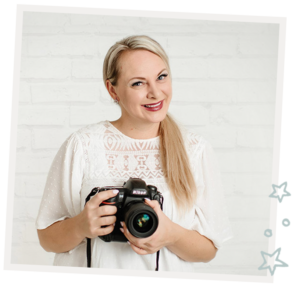
I'm
Lisa DiGeso
I’m on a mission to create uplifting online experiences for photographers ready to elevate their art, their business and their mindset.(...and have fun along the way!)

